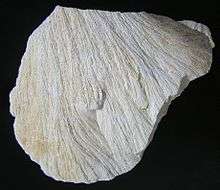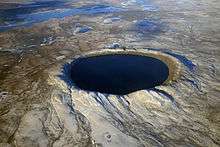Shatter cone

Shatter cones are rare geological features that are only known to form in the bedrock beneath meteorite impact craters or underground nuclear explosions. They are evidence that the rock has been subjected to a shock with pressures in the range of 2-30 GPa.[1][2][3]
Morphology
Shatter cones have a distinctively conical shape that radiates from the top (apex) of the cones repeating cone-on-cone in large and small scales in the same sample. Sometimes they have more of a spoon shape on the side of a larger cone.[2] In finer-grained rocks such as limestone, they form an easily recognizable "horsetail" pattern with thin grooves (striae). However, the word "striae" should not be used to describe shatter cones, as that is considered misleading.
Coarser grained rocks tend to yield less well developed shatter cones, which may be difficult to distinguish from other geological formations such as slickensides. Geologists have various theories of what causes shatter cones to form, including compression by the wave as it passes through the rock or tension as the rocks rebound after the pressure subsides. The result is large and small branching fractures throughout the rocks.[1][2][3]
Shatter cones can range in size from microscopic to several meters. The largest known shatter cone in the world (more than 10 metres in length) is located at the Slate Islands in Terrace Bay, Ontario, Canada. The azimuths of the cones' axes typically radiate outwards from the point of impact, with the cones pointing upwards and toward the center of the impact crater, although the orientations of some of the rocks have been changed by post-cratering geological processes at the site.
Photo gallery
- Approximately 10-metre-tall shatter cone located in McGreevy Harbour, Slate Islands, Ontario, Canada
- Close-up of shatter cones developed in fine grained dolomite from the Wells Creek crater, USA
- Shatter cones developed in fine grained dolomite from the Wells Creek crater, USA
 30-centimetre-sized shatter cone in the Saint Gervais granite from the Rochechouart crater, France
30-centimetre-sized shatter cone in the Saint Gervais granite from the Rochechouart crater, France Shatter cones in the Santa Fe impact structure near Santa Fe, New Mexico
Shatter cones in the Santa Fe impact structure near Santa Fe, New Mexico Shatter cone developed in fine grained limestone from the Charlevoix crater, Québec, Canada, Collection of the Observatoire de l'Astroblème de Charlevoix
Shatter cone developed in fine grained limestone from the Charlevoix crater, Québec, Canada, Collection of the Observatoire de l'Astroblème de Charlevoix
See also
References
- 1 2 French, B.M. (1998). Traces of catastrophe. Lunar and Planetary Institute. Retrieved 2007-05-20.
- 1 2 3 Sagy, A.; Fineberg, J.; Reches, Z. (2004). "Shatter cones: Branched, rapid fractures formed by shock impact" (PDF). Journal of Geophysical Research. 109: B10209. Bibcode:2004JGRB..10910209S. doi:10.1029/2004JB003016.
- 1 2 French, Bevan M. (2005). "Stalking the Wily Shatter Cone: A Critical Guide for Impact-Crater Hunters" (pdf). Impacts in the Field. Impact Field Studies Group. 2 (Winter): s 3–10.
| Wikimedia Commons has media related to Shatter cones. |

